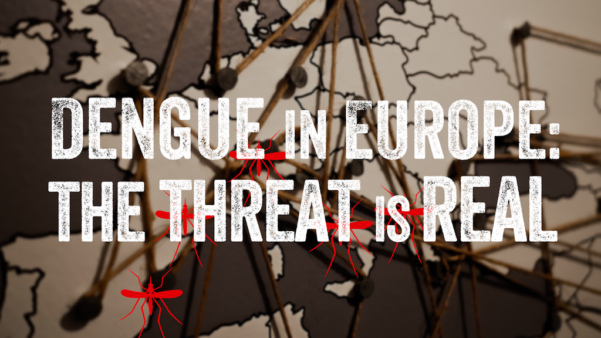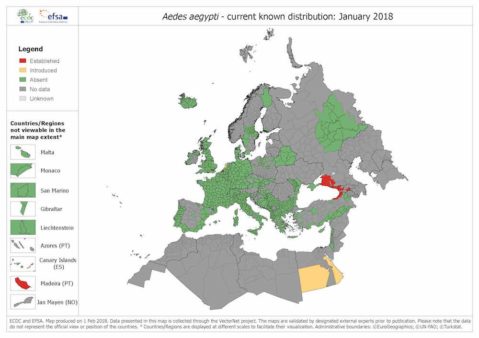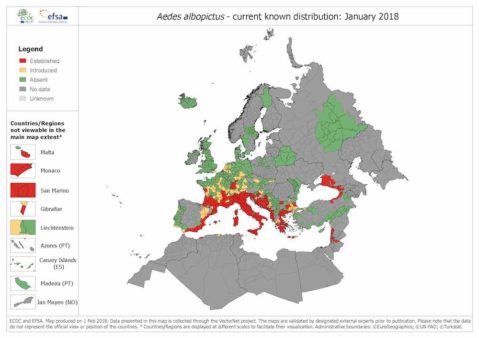- by Alison
Dengue in Europe: the threat is real

Before 1970, only nine countries had experienced severe dengue epidemics. The disease is now endemic in more than 100 countries, as The World Health Organization (WHO) confirms. It can be found in the Americas, South-East Asia and Western Pacific, Africa and the Eastern Mediterranean, with the first three of those regions most seriously affected. But what about dengue in Europe?
Europe is no stranger to dengue; Greece suffered a major outbreak in 1927. The first reports of local transmission of dengue in Europe in recent times came in 2010, from France and Croatia. That year, three other European countries detected imported cases of the virus.
Did Cristiano Ronaldo start a dengue outbreak?
Just two years later, in 2012, the Madeira islands of Portugal found themselves in the midst the first outbreak of dengue in Europe since 1927. Mainland Portugal, along with ten other European countries, also detected imported cases of dengue in 2012.
Dengue is a vector-borne disease, primarily spread by Aedes aegypti mosquitoes. The dengue outbreaks in France and Croatia in 2010, however, were caused by its secondary and less potent vector, Aedes albopictus (commonly known as the Asian tiger mosquito).
Dengue in Europe: understanding vectorial capacity
As with all vector-borne diseases, the dynamics of dengue transmission are extremely complex. Many of the factors that affect it are linked to the mosquitoes’ ability to survive, thrive and spread the virus in a particular territory.
“For a dengue outbreak to occur in Europe, there must be sufficient Aedes vectors, and the dengue virus must be present,” says Dr. Jing Helmersson, an epidemiologist at Umea University in Sweden. “There also needs to be enough susceptible humans and a suitable environment, with climate the main factor.”
Dr. Jing Helmersson is interested in the link between climate and the potential for dengue transmission. She drew on her mathematical background to develop mathematical models that predict ‘temperature-dependant vectorial capacity’ and estimate the likelihood of dengue epidemics.
In other words, she built a model to explore whether the temperature in parts of Europe would be sufficient for Aedes aegypti mosquitoes to become established and then if the dengue virus was introduced, spread by both Aedes aegypti and Aedes albopictus.
Aedes making itself at home
Until recently, Aedes aegypti could only be found in three regions of Europe: small coastal areas of the Black Sea in Georgia and southwestern portions of Russia, in addition to the Madeira Islands of Portugal. However, the European Centre for Disease Prevention and Control (ECDC) reports new settlements of Aedes aegypti on the island of Fuerteventura in the Canary Islands. It adds “The species is now spreading to the west along the Black Sea coast of Turkey.”

Image via ECDC
And we should also not forget Aedes albopictus. ECDC reports sightings of this secondary dengue vector across more than 25 European countries, primarily around the Mediterranean.

Image via the ECDC
The Paris Agreement
Dr. Helmersson has linked her research into the likelihood of dengue outbreaks in Europe to the Paris Agreement, a treaty on greenhouse gas emission reductions agreed at the 2015 Paris Climate Conference. The agreement sets out a global action plan to limit global warming to well below 2°C to avoid dangerous climate change. She looks at different scenarios, each with a different level of greenhouse gas emissions and different level of global warming.
Her best-case scenario assumes we will achieve the greenhouse gas levels set in the Paris Agreement. In it, annual greenhouse gas emission peaks during 2010-2020 and declines substantially after that, limiting global warming to below 2°C relative to the pre-industrial level. This scenario predicts Aedes aegypti could potentially cause a dengue outbreak in Nice and Paris, in addition to Málaga, Athens, and Rome, where Aedes aegypti could cause a dengue outbreak today if the mosquito is abundant. In this scenario, the region where Aedes albopictus could potentially cause an outbreak of dengue (if all the necessary conditions coincide and the dengue virus circulates over a period of time) is unlikely to spread further afield from where it is today: Málaga, Athens, and Rome.
Her worst-case scenario would occur if we don’t do anything to address greenhouse gas emissions and they – along with temperatures – continue to rise throughout this century. In this scenario, alarmingly the region where mosquitoes could potentially cause a dengue outbreak (if both mosquitoes are abundant and the virus is introduced) spreads as far north as Stockholm for Aedes aegypti and as far north as Berlin for Aedes albopictus.
Healthier lifestyles
In a nutshell, Dr. Henlmersson’s research clearly shows there is a substantial risk for dengue in Europe by the end of the century if we don’t do something to reduce greenhouse gases.
With a longstanding interest in health, Dr. Helmersson says adopting a healthier lifestyle is key to reducing greenhouse gas emissions and avoiding dangerous climate change: “We can all contribute to climate change. We can eat less meat and walk or cycle instead of taking the gasoline car.”
In terms of what Europe needs to do as the threat of dengue rises, Dr. Helmersson advocates dengue surveillance combined with chemical-free vector control, such as reducing mosquito breeding sites – with governments, local authorities and individuals all playing their part.
If you’ve been unfortunate enough to experience dengue while traveling in Europe, we’d love to hear your story.
—

